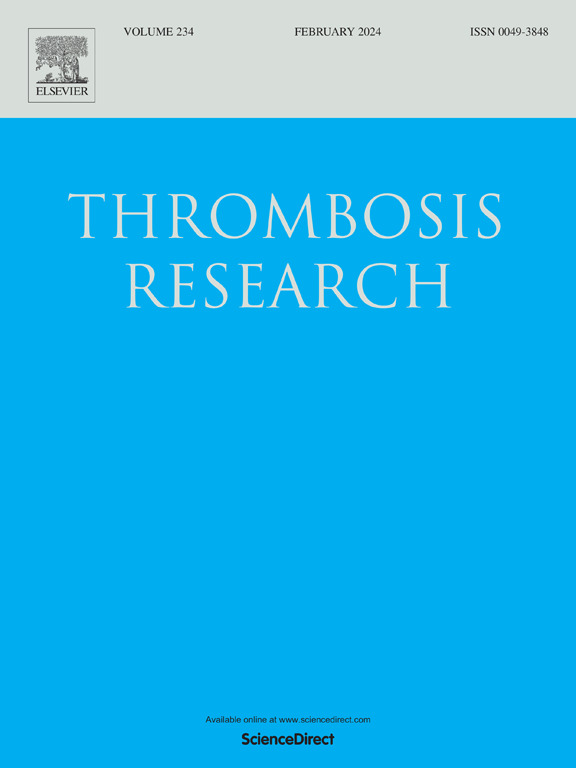SSA-sMLP: A venous thromboembolism risk prediction model using separable self-attention and spatial-shift multilayer perceptrons
IF 3.7
3区 医学
Q1 HEMATOLOGY
引用次数: 0
Abstract
Accurate risk assessment of Venous Thromboembolism (VTE) holds significant value for clinical decision-making. However, traditional scoring systems relying on linear assumptions and expert experience, along with machine learning models constrained by shallow architectures, fail to effectively model the high-order nonlinear interactions and local dynamic correlations among multidimensional medical features. To address the systematic deficiency in multi-dimensional feature integration of existing VTE data, this study constructed VTE Data - a dataset encompassing multi-dimensional features - based on 113,836 clinical records from a hospital. For VTE risk assessment, we propose a deep learning model integrating separable self-attention and the improved Spatial-Shift Multi-Layer Perceptron (SSA-sMLP). The separable self-attention module enables dynamic cross-dimensional feature interaction modeling through dynamic context vectors and a linear decoupling strategy. The improved Spatial-Shift MLP (-MLPv2) employs parameter-free shift operations to reorganize different feature subsets, combined with Split Attention for adaptive weight allocation, thereby precisely capturing local non-linear associations. Experimental evaluations on VTE Data using the Caprini RAM (2010) demonstrated that the proposed model (87.99 %) achieves 33.95 % improvement in accuracy over the existing best model, along with superior robustness (F1-score: 65.9 %), while maintaining computational efficiency comparable to mainstream models. By modular integration of separable self-attention and -MLPv2 architecture, the SSA-sMLP achieves dual enhancement in feature interaction modeling efficiency and precision, providing an innovative solution that balances computational efficiency and model performance for medical VTE risk assessment tasks.
SSA-sMLP:基于可分离自注意和空间移位多层感知器的静脉血栓栓塞风险预测模型
静脉血栓栓塞(VTE)的准确风险评估对临床决策具有重要价值。然而,传统的评分系统依赖于线性假设和专家经验,以及受浅架构约束的机器学习模型,无法有效地模拟多维医学特征之间的高阶非线性相互作用和局部动态相关性。为解决现有VTE数据在多维特征整合方面的系统性不足,本研究基于某医院113,836份临床记录构建了包含多维特征的VTE _ data数据集。对于VTE风险评估,我们提出了一种集成可分离自注意和改进的空间移位多层感知器(SSA-sMLP)的深度学习模型。可分离自注意模块通过动态上下文向量和线性解耦策略实现动态跨维特征交互建模。改进的Spatial-Shift MLP (S2-MLPv2)采用无参数移位操作对不同的特征子集进行重组,并结合Split Attention进行自适应权重分配,从而精确捕获局部非线性关联。使用Caprini RAM(2010)对VTE _数据进行实验评估,结果表明,该模型(87.99%)比现有最佳模型的准确率提高了33.95%,同时具有优异的鲁棒性(F1-score: 65.9%),同时保持了与主流模型相当的计算效率。SSA-sMLP通过模块化集成可分离自注意和S2-MLPv2架构,实现了特征交互建模效率和精度的双重提升,为医疗VTE风险评估任务提供了一种平衡计算效率和模型性能的创新解决方案。
本文章由计算机程序翻译,如有差异,请以英文原文为准。
求助全文
约1分钟内获得全文
求助全文
来源期刊

Thrombosis research
医学-外周血管病
CiteScore
14.60
自引率
4.00%
发文量
364
审稿时长
31 days
期刊介绍:
Thrombosis Research is an international journal dedicated to the swift dissemination of new information on thrombosis, hemostasis, and vascular biology, aimed at advancing both science and clinical care. The journal publishes peer-reviewed original research, reviews, editorials, opinions, and critiques, covering both basic and clinical studies. Priority is given to research that promises novel approaches in the diagnosis, therapy, prognosis, and prevention of thrombotic and hemorrhagic diseases.
 求助内容:
求助内容: 应助结果提醒方式:
应助结果提醒方式:


